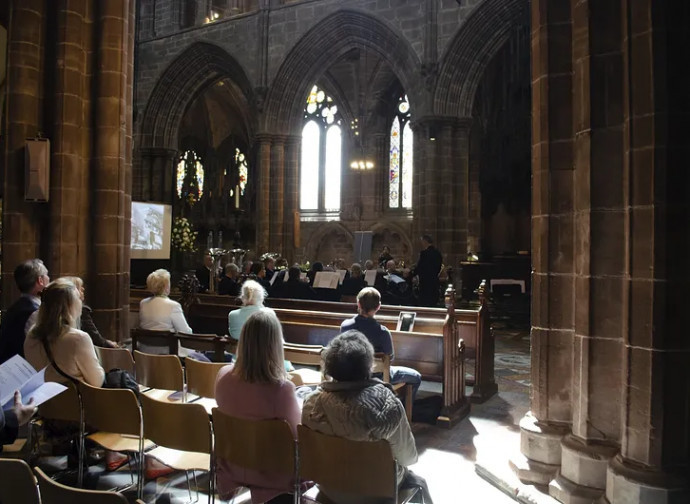Ireland: Catholics take a nosedive on the island of saints
It is not surprising there is a decline in the number of Irish who consider themselves Catholic, it's the rapidity: 10% less in just six years that’s disconcerting. For many, it is an opportunity to oust the Church from society. While the Church will have to adopt a proactive mentality, if it wants to avoid being overwhelmed definitively.

Once the land of saints and scholars, Ireland is becoming less religious, data from the country’s most recent census shows. Just over half of residents in the Irish capital – Dublin – now self-identify as Catholic, according to data released by the Central Statistics Office (CSO). Meanwhile, the fall in the numbers of people self-identifying as Catholic across the state, down from 79% in 2016 to 69% in 2022, has led to predictable calls from secularists and anti-Church campaigners to kick the Church out of education, healthcare and other social infrastructure.
The decline is even more pronounced when compared against the 2011 census, when 84.2% of Irish residents describing themselves as Catholic. Some 3,515,861 Irish residents now describe themselves as Catholic, with the total number of Catholics falling by 180,783 since the last census in 2016.
While the numbers of Catholics decline, those describing themselves as having “no religion” increased by 284,269 and stood at 736,210. This means that 14% of Irish residents ticked the “no religion” box on the census form. The decline is most pronounced in Dublin, which has the lowest percentage of Catholics in the Irish Republic. Just over half of Dublin residents – 53% - choose to identify as Catholic. “No religion” was recorded for 24% of people living in Dún Laoghaire-Rathdown in Dublin, the highest for any region.
Catholic identity remains stronger in rural parts of Ireland, with Co. Mayo in the west reporting the highest proportion of Catholics at 80%, closely followed by other rural regions such as Tipperary, Offaly, Roscommon and Galway county, all of which report 79%. Just 7% of the people of Co. Monaghan ticked the “no religion box”. The Anglican Church – the Church of Ireland – showed little change, remaining the second largest religious category with 124,749 people.
As you dig further into the figures, the picture is not entirely as clear-cut as the 10% decline since 2016 suggests. For a start, some of that decline may be attributed to changes in migration patterns. The data shows that among Irish citizens, 94% self-identify as Catholics. But the number of Polish people, for example (who tend to be Catholic) dropped by 24% in six years, down from 122,515 in 2016 to 92,887.
Meanwhile, over the six-year period, the number of people who described themselves as Orthodox Christians increased from 60,000 to just over 100,000 people. This increase is at least partly attributable to the more than 70,000 refugees from the war in Ukraine who have sought asylum in Ireland. Similarly, rises in the number of people identifying as Muslim – from 63,443 in 2016 to 81,930 in 2022 – Hindu and non-denominational or evangelical Christians is a trend related to new migration patterns. It is also a trend we are likely to see continuing.
Equally, all this cross comparison between with other past census is dangerous due to a change in the wording of the question relating to religion. A briefing note from the CSO warned that “The question on religion used in Census 2022 differed from the Census 2016 version, which may impact comparability,” it said.
Traditionally, the question was phrased as “What is your religion?” However, in 2022 the question asked, “What is your religion, if any?” Additionally, while “Catholic” had always been the first option to tick, in 2022 “no religion” was offered as the first response option.
Having given these caveats, it still must be said that a decline in the number of Catholics in Ireland comes as a surprise to no one, least of all the Church. Although we still have one of the highest Mass attendance rates in Europe, our pews are emptying and diocesan surveys show attendances to be heavily skewed toward the elderly.
We have lost the last two generations, at the very least, due to a mixture of scandals, mismanagement and apathy. The speed of the decline – 10% in six years – is perhaps a surprise and certainly does not bode well for the Church’s future. The full breakdown of figures data relating to religious affiliation won’t come out until Autumn this year. When it does, the Church should pour over it with the intention of forming a plan of action. Ultimately, a mindset of maintaining the Church will not suffice – we need to be pro-active.
In the meantime, members of our political elite and NGO sectors will continue to seize on the figures as an opportunity to amplify their calls to kick the Church out of the education and healthcare sectors in particular. In all areas of Irish life – political, cultural and social – the Church is going be squeezed out unless we can arrest the decline.
* The Irish Catholic


